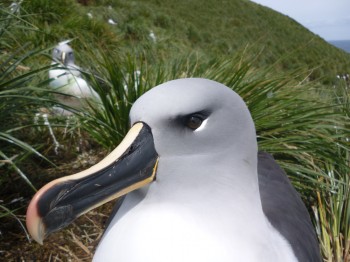Sally Poncet and colleagues have published in the journal Polar Biology on recent trends in numbers of ACAP-listed Wandering Diomedea exulans, Black-browed Thalassarche melanophris and Grey-headed T. chrysostoma Albatrosses breeding at South Georgia (Islas Georgias del Sur)*.
The paper’s abstract follows:
“South Georgia supports globally important populations of seabirds, including the wandering albatross Diomedea exulans, black-browed albatross Thalassarche melanophris and grey-headed albatross T. chrysostoma, currently classified by the world Conservation Union (IUCN) as vulnerable, near threatened and endangered, resprectively. Surveys of these species at South Georgia were conducted during the incubation stage in November 2014 to January 2015, repeating previous surveys conducted in the 2003/2004 season. Numbers of wandering albatrosses breeding annually at South Georgia decreased by 18% (1.8% per year) from 1553 pairs in 2003/2004 to an estimated 1278 pairs in 2014/2015. Over the same period, black-browed and grey-headed albatrosses decreased by 19% (1.9% per year) and 43% (5% per year), respectively. These represent a continuation of negative trends at South Georgia since the 1970s and are in contrast to some populations elsewhere, which have shown signs of recent recovery. Given the importance of South Georgia for these species, the ongoing population declines, and in the case of grey-headed albatrosses, an acceleration of the decline is of major conservation concern. Incidental fisheries mortality (bycatch) is currently considered to be the main threat. Although seabird bycatch has been reduced to negligible levels in the fisheries operating around South Georgia, wider implementation of effective seabird bycatch mitigation measures is required to improve the conservation status of the South Georgia populations of wandering, black-browed and grey-headed albatrosses. In addition, more research is required to investigate the respective roles of bycatch and climate change in driving these population trends.”

Grey-headed Albatross on Bird Island, South Georgia (Islas Georgias del Sur), photograph by Richard Phillips
With thanks to Jen Lee and Anton Wolfaardt.
Reference:
Poncet, S., Wolfaardt, A.C., Black, A., Browning, S., Lawton, K., Lee, J., Passfield, K., Strange, G., Phillips, R.A. 2017. Recent trends in numbers of wandering (Diomedea exulans), black-browed (Thalassarche melanophris) and grey-headed (T. chrysostoma) albatrosses breeding at South Georgia. Polar Biology doi:10.1007/s00300-016-2057-0.
John Cooper, ACAP Information Officer, 11 January 2017
*A dispute exists between the Governments of Argentina and the United Kingdom of Great Britain and Northern Ireland concerning sovereignty over the Falkland Islands (Islas Malvinas), South Georgia and the South Sandwich Islands (Islas Georgias del Sur y Islas Sandwich del Sur) and the surrounding maritime areas.

 English
English  Français
Français  Español
Español